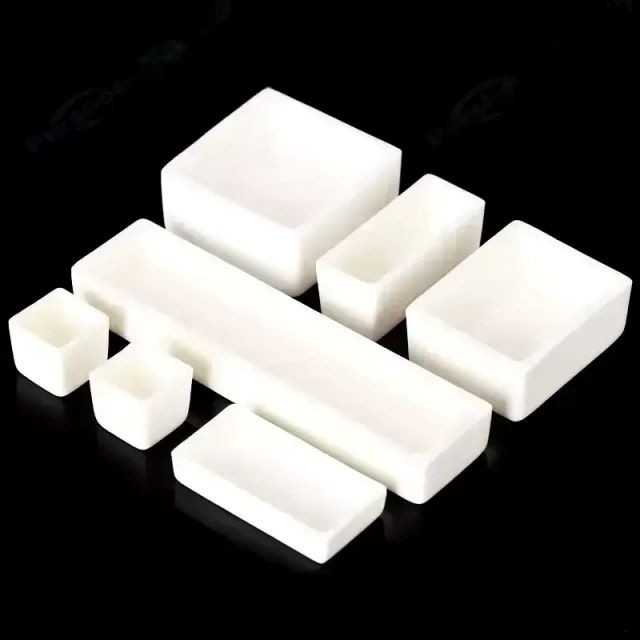
fine ceramics
Engineering Advanced Fine Alumina Al2O3 Ceramic Crucible for Laboratory Muffle Furnace
Item Number : KM-C01
Price varies based on specs and customizations
- Material
- Aluminum oxide
- Specification
- See form
Shipping:
Contact us to get shipping details Enjoy On-time Dispatch Guarantee.
Why Choose Us
Reliable PartnerEasy ordering process, quality products, and dedicated support for your business success.
Application
Alumina ceramic crucibles are versatile and durable vessels for thermal analysis testing. Made of high-quality alumina ceramic, it has the characteristics of high melting point, strong hardness, good chemical stability, and can withstand extreme temperatures, corrosion and wear. Its smooth surface allows for easy sample removal, while its high thermal conductivity ensures accurate temperature readings during testing. It is a good material for high temperature resistance and chemical corrosion resistance. Alumina sample pans are widely used in thermal analysis such as DTA and DSC to provide consistent and precise results in thermal analysis tests.
- Material Testing: Alumina ceramic crucibles for precise thermogravimetric analysis.
- Metallurgical Processes: High-temperature and chemically resistant crucibles for smelting, casting, and refining metal alloys.
- Environmental Testing: Acid-resistant crucibles for accurate measurement of pollutants and toxins in soil and water samples.
- Drug Research: Crucibles used to analyze thermal properties of drug molecules, aiding in drug development.
- Ceramic and Glass Manufacturing: Crucibles designed to withstand extreme temperatures and thermal shock for molten glass and ceramic materials during production.
Detail & Parts
Model 1 & Model 2
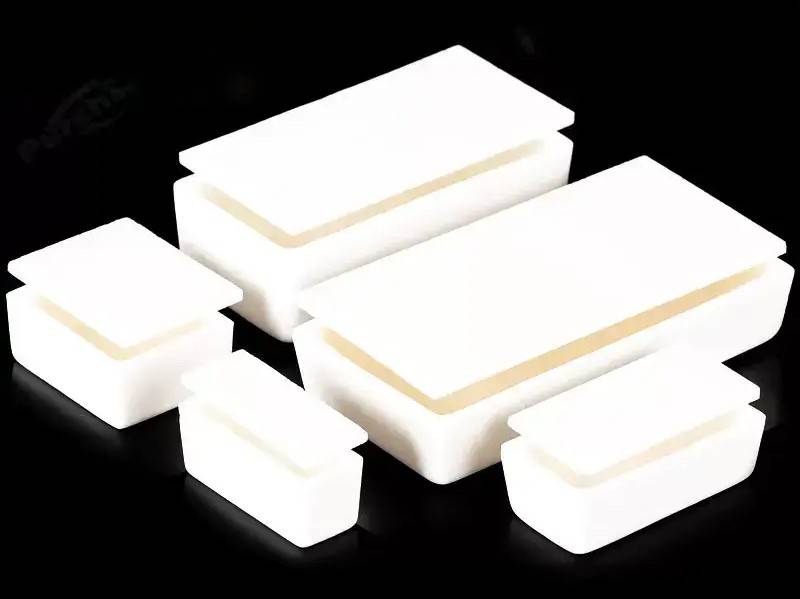
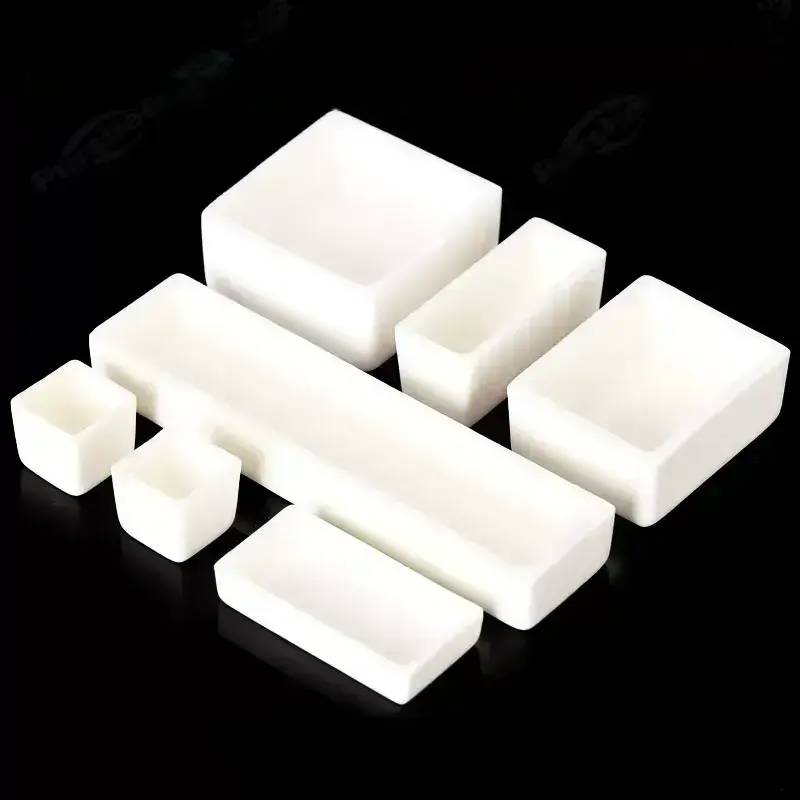
| 0.9ml(45x8x6mm) | 9ml(60x30x10mm) | 30ml(60x40x20mm) | 185ml(80x80x40mm) | 13ml(100x30x10mm) | 300ml(100x100x40mm) | 510ml(120x120x50mm) | 800ml(200x100x50mm) |
| 2ml(30x20x10mm) | 10ml(50x20x20mm) | 35ml(60x30x30mm) | 75ml(90x60x20mm) | 25ml(100x30x15mm) | 750ml(100x100x100mm) | 520ml(140x140x38mm) | 2600ml(200x200x80mm) |
| 3ml(25x15x15mm) | 10ml(60x30x14mm) | 40ml(50x50x25mm) | 165ml(90x60x40mm) | 35ml(100x30x20mm) | 330ml(115x115x35mm) | 425ml(150x150x30mm) | 3300ml(200x200x100mm) |
| 3.5ml(20x20x17mm) | 16ml(60x30x15mm) | 57ml(75x75x15mm) | 200ml(90x60x45mm) | 59ml(100x30x30mm) | 90ml(120x60x20mm) | 750ml(150x150x50mm) | 3900ml(250x250x80mm) |
| 4ml(50x20x10mm) | 20ml(60x30x20mm) | 68ml(65x65x25mm) | 170ml(90x90x30mm) | 47ml(100x40x20mm) | 190ml(120x60x40mm) | 1290ml(150x150x80mm) | 4800ml(250x250x100mm) |
| 5ml(30x20x17mm) | 25ml(50x40x20mm) | 100ml(65x65x35mm) | 300ml(90x90x45mm) | 110ml(100x50x30mm) | 205ml(120x80x30mm) | 800ml(160x160x45mm) | 11000ml(330*330*120mm) |
| 7ml(50x20x15mm) | 26ml(50x25x35mm) | 110ml(70x70x30mm) | 22ml(100x20x20mm) | 150ml(100x100x25mm) | 260ml(120x80x40mm) | 1460ml(180x180x60mm) |
Model 3

| 3.5ml(20x20x17mm) | 10ml(60x30x14mm) | 25ml(100x30x20mm) | 125ml(98x72x28mm) |
| 5.5ml(45x22x13mm | 15ml(30x30x30mm) | 30ml(80x40x17mm) | 1800ml(380x135x60mm) |
| 9ml(60x25x15mm) | 15ml(60x30x15mm) | 50ml(90x60x17mm) | |
| 10ml(50x28x14mm) | 22ml(100x25x15mm) | 84ml(120x60x18mm) |
Model 4

| 9ml(60x25x15mm) | 50ml(85x30x40mm) | 125ml(98x72x28mm) | 1050ml(150x150x60mm) | 1800ml(380x135x60mm) |
| 15ml(60x30x15mm) | 84ml(120x60x18mm) | 460ml(160x120x35mm) | 1290ml(150x150x80mm) | 4000ml(225x225x100mm) |
| 15ml(30x30x30mm) | 95ml(120x100x15mm) | 710ml(155x120x50mm) | 1800ml(150x100x150mm) | |
| 22ml(100x25x15mm) | 100ml(100x50x30mm) | 900ml(120x120x100mm) | 4400ml(200x150x200mm) |
Model 5

| 0.9ml(45x8x6mm) | 59ml(100x30x30mm) | 260ml(100x100x35mm) | 1880ml(340x220x35mm) | 6900ml(330x330x80mm) |
| 3ml(25x15x15mm) | 84ml(65x65x30mm) | 425ml(150x150x30mm) | 3120ml(300x150x90mm) | 14L(330x330x160mm) |
| 5ml(30x20x17mm) | 170ml(170x53x30mm) | 445ml(100x100x60mm) | 3300ml(200x200x100mm) | |
| 16ml(40x30x20mm) | 200ml(115x90x30mm) | 1090ml(140x140x70mm) | 3760ml(300x200x80mm) | |
| 35ml(70x30x30mm) | 230ml(115x65x45mm) | 1260ml(160x120x85mm) | 4000ml(235x165x130mm) |
Model 6

| One big (50x40x20) and two small (30x20x17) | One large (90x65x30) four small (50x20x20) | One large (100x30x20) four small (20x20x17) | One large (115x90x30) five small (75x20x20) | One big (120x60x20) and two small (50x40x20) |
| One big (80x80x40) and two small (60x30x30) | One big (90x65x30) and two small (50x40x20) | One large (100x30x20) and three small (30x20x17) | One large (115x115x35) and three small (100x30x20) | One big (120x60x20) and two small (100x20x20) |
| One Big (90x60x20) Four small (50x20x20) | One Large (90x65x30) and three small (52x25x23) | One Large (100x40x20) and three small (φ28x17) | One big (120x30x15) five small (20x20x17) | One big (120x60x20) five small (50x20x20) |
| One large (90x60x17 ) and three small (50x28x1) | One large (100x30x15) and three small (30x20x10) | One Large (100x40x20) and three small (φ30x30) | One large (115x115x35) and three small (100x30x20) | One large (120x60x40) and three small (40x35x25) |
| One big (90x60x20) and two small (50x40x20) | One big (100x30x20) five small (φ18x26) | One large (100x100x40) nine small (10ml ) | One large (120x35x18) seven small (25x15x15) | One large (120x80x30) six small (20ml ) |
| One big (90x60x20) five small (80x10x10) | One large (100x30x20) and four small (φ20x20) | One Large (115x65x45) and four small (50x25x35) | One large (120x60x18 ) and four small (50x28x14) | One large (120x80x40) six small (15ml) |
Model 7
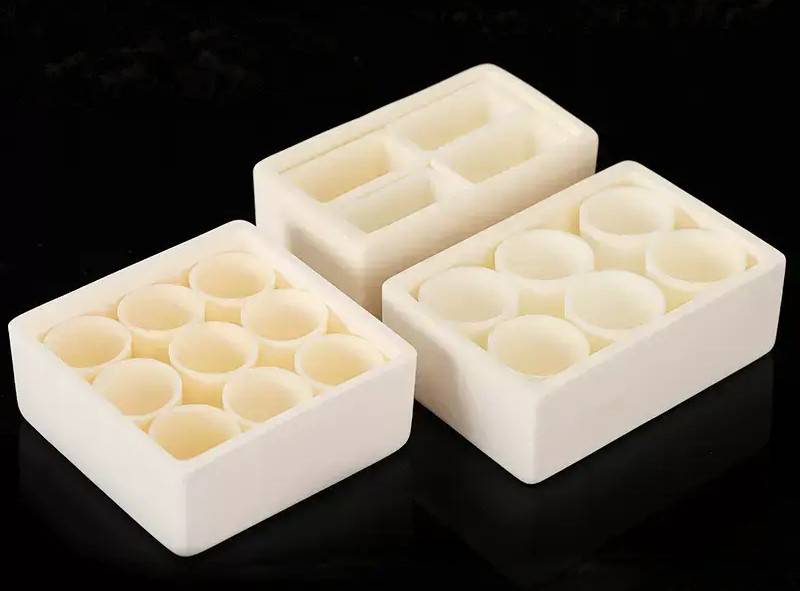
| One large (φ58x60) and seven small (φ16x50) | One large (100x40x20) and three small (φ28x17) | One large (120x60x20) two small (100x20x20 semicircle) |
| One large (φ70x70) and three small (φ28x58) | One large (100x40x20) and three small (φ30x30) | One large (120x60x40) and three small (40x35x25 semicircle) |
| One large (100x30x20) and four small (φ20x20) | One large (100x100x40) nine small (10ml regular) | One large (120x80x40) six small (15ml) |
| One big (100x30x20) five small (φ18x26) | One large (115x65x45) four small (50x25x35) | One large (120x80x30) six small (20ml heightened) |
Model 8

| 2ml(50x10x10mm) | 7ml(50x20x15mm) | 68ml(65x65x25mm) | 110ml(100x50x30mm) | 165ml(90x60x40mm) | 1000ml(150x110x80) |
| 2.5ml(70x12x7mm) | 15ml(75x20x20mm) | 75ml(90x60x20mm) | 115ml(65x65x35mm) | 170ml(90x90x30mm) | 2000ml(160x140x120mm) |
| 4ml(50x20x10mm) | 34ml(150x20x20mm) | 85ml(120x60x18mm) | 120ml(90x65x30mm) | 185ml(80x80x40mm) | 2600ml(200x200x80mm) |
| 4.5ml (80x10x10mm) | 57ml(75x75x15mm) | 80ml(120x60x18mm) | 135ml(95x68x28mm) | 185ml(94x68x38mm) | 4800ml(250x250x100mm) |
| 7ml(50x25x10mm) | 63ml(150x45x20mm) | 90ml(120x60x20mm) | 160ml(78x28x107) | 520ml(140x140x38mm) |
Model 9

| 1.5ml with holes (30x10x9.5mm) | 60ml(100x43x26mm) |
| 19ml(100x24x17) | 114ml(100x56x35mm) |
| 24ml(73x30x22mm) | 175ml(100x84x35mm) |
| 36ml(100x27x27mm) | Other specifications can be customized |
Model 10

| 0.9ml with lid (45x8x6mm) | 26ml with lid (50x25x35mm) | 80ml with lid (120x60x18mm) | 150ml with lid (100x100x25mm) | 330ml with lid (115x115x35mm) | 520ml with lid (140x140x38mm) |
| 3ml with lid (25x15x15mm) | 40ml with lid (50x50x25mm) | 84ml with lid (65x65x30mm) | 160ml with lid (78x28x107mm) | 370ml with lid (200x100x25mm) | 750ml with lid (150x150x50mm) |
| 4ml with lid (50x20x10mm) | 59ml with lid (100x30x30mm) | 100ml with lid (65x65x35mm) | 170ml with lid (90x90x30mm) | 425ml with lid (150x150x30mm) | 800ml with lid (200x100x50mm) |
| 7ml with lid (50x20x15mm) | 60ml with lid (105x105x12mm) | 100ml with lid (100x50x30mm) | 260ml with lid (100x100x35mm) | 445ml with lid (100x100x60mm) | 900ml with lid (120x120x100mm) |
| 7ml with lid (50x25x10mm) | 68ml with lid (65x65x25mm) | 110ml with lid (70x70x30mm) | 310ml with lid (105x105x40mm) | 510ml with lid (120x120x50mm) |
Model 11

| 4ml(50x20x10mm) | 26ml(50x25x35mm) | 195ml(85x80x40mm) | 800ml(200x100x50mm) | 3100ml(220x220x80mm) |
| 5.5ml(100x10x10mm) | 30ml(60x40x20mm) | 200ml(90x60x45mm) | 1100ml(305x90x60mm) | 298ml(200x100x30mm) |
| 10ml(75x18x14mm) | 35ml(120x30x15mm) | 205ml(120x80x30mm) | 1480ml(200x200x50mm) | |
| 16ml(60x30x15mm) | 150ml(100x100x25mm) | 210ml(85x85x40mm) | 2400ml(250x155x80mm) | |
| 20ml(52x25x23mm) | 190ml(120x60x40mm) | 370ml(200x100x25mm | 2830ml(300x180x70mm) |
Model 12

| 1050ml with lid (150x150x60mm) | 1460ml with lid 180x180x60 | 2600ml with lid 200x200x80 | 6900ml with lid (330x330x80mm) |
| 1090ml with lid (140x140x70mm) | 1480ml with lid 200x200x50 | 4400ml with cover (200x150x200mm) | 11000ml with cover 330x330x120 |
| 1290ml with lid (150x150x80mm) | 2830ml with cover 300x180x70 | 4800ml with cover (250x250x100mm) | 14L with cover (330x330x160mm) |
Model 13

| 4ml with lid 20x20x18mm | 3.5ml with lid 20x20x17mm |
Model 14

| 800ml(130x120x75mm) | 1300ml(130x120x115mm) |
The crucibles we show are available in different sizes and custom sizes are available on request.
Advantages
- High temperature resistance: long-term use at 1600°C, short-term use at 1800°C (Al2O3≥99%), suitable for melting, sintering, annealing and other occasions.
- Low Thermal Conductivity: Minimizes thermal shock for safe handling even when very hot.
- Superior Durability: Withstands multiple heating and cooling cycles without cracking or deforming.
- Easy to clean and cost-effective.
- Broad Material Compatibility: Compatible with metals, salts, organics and a wide variety of laboratory chemicals.
- Non-toxic, safe for laboratory use.
Designed for You
KinTek provide deep custom made service and equipment to worldwide customers, our specialized teamwork and rich experienced engineers are capable to undertake the custom tailoring hardware and software equipment requirements, and help our customer to build up the exclusive and personalized equipment and solution!
Would you please drop your ideas to us, our engineers are ready for you now!
FAQ
What Are The Main Applications Of Fine Ceramics?
What Are Advanced Ceramics?
What Are Muffle Furnace Used For?
What Is CVD (Chemical Vapor Deposition) And What Are Its Key Advantages?
What Are Engineering Ceramics?
What Are The Main Differences Between Square And Cylindrical Crucibles?
What Are The Common Applications Of Alumina Crucibles?
What Are The Advantages Of Using Ceramic Crucibles?
What Are The Main Types Of Fine Ceramics?
What Are The Main Types Of Advanced Ceramics?
What Are The Types Of Muffle Furnace?
What Are Some Common Applications Of CVD Materials?
What Are The Main Types Of Engineering Ceramics?
What Are The Advantages Of Using Alumina Crucibles?
What Are Some Common Uses Of Ceramic Crucibles?
What Is The Principle Behind Fine Ceramics?
What Are The Applications Of Advanced Ceramics?
What Is Muffle Furnace In Chemistry?
What Types Of CVD Materials Are Available?
What Are The Applications Of Engineering Ceramics?
How Should Alumina Crucibles Be Handled And Maintained?
How Can I Choose The Right Ceramic Crucible For My Application?
What Are The Advantages Of Using Fine Ceramics?
How Are Advanced Ceramics Manufactured?
What Is The Use Of Muffle Furnace For Ash?
How Does CVD Diamond Enhance The Performance Of Cutting Tools?
How Do Engineering Ceramics Differ From Traditional Ceramics?
How Should Ceramic Crucibles Be Handled And Maintained?
What Are The Advantages Of Using Advanced Ceramics?
What Is The Temperature Of Muffle Furnace?
What Makes CVD Diamond Domes Suitable For High-performance Loudspeakers?
What Are The Advantages Of Using Alumina Ceramics?
What Is The Difference Between Alumina And Zirconia Ceramics?
How Does CVD Diamond Improve Thermal Management In Electronic Devices?
Why Are Zirconia Ceramics Preferred In Certain Applications?
Why Are Silicon Carbide Ceramics Used In High-temperature Applications?
What Makes Silicon Carbide Ceramics Suitable For High-temperature Applications?
What Makes Boron Nitride Ceramics Unique?
How Are Boron Nitride Ceramics Used In Electronics?
How Do Advanced Ceramics Contribute To Energy Efficiency?
What Is The Manufacturing Process Of Engineering Ceramics?
Can Engineering Ceramics Be Customized For Specific Applications?
4.9
out of
5
These crucibles are a lifesaver in the lab. They can withstand high temperatures and are easy to clean. I've been using them for a few months now and they're still in great condition.
4.7
out of
5
I'm a chemist and I use these crucibles for a variety of experiments. They're durable and can withstand high temperatures. I've never had one break on me.
4.8
out of
5
These crucibles are a great value for the price. They're made of high-quality materials and they're very durable. I've been using them for a few months now and they're still in great condition.
4.9
out of
5
I'm a metallurgist and I use these crucibles for melting and casting metals. They're very durable and can withstand high temperatures. I've never had one fail on me.
4.7
out of
5
These crucibles are perfect for my laboratory needs. They're made of high-quality materials and they're very durable. I've been using them for a few months now and they're still in great condition.
4.8
out of
5
I'm a chemist and I use these crucibles for a variety of experiments. They're very durable and can withstand high temperatures. I've never had one break on me.
4.9
out of
5
These crucibles are a great value for the price. They're made of high-quality materials and they're very durable. I've been using them for a few months now and they're still in great condition.
4.7
out of
5
I'm a metallurgist and I use these crucibles for melting and casting metals. They're very durable and can withstand high temperatures. I've never had one fail on me.
4.8
out of
5
These crucibles are perfect for my laboratory needs. They're made of high-quality materials and they're very durable. I've been using them for a few months now and they're still in great condition.
4.9
out of
5
I'm a chemist and I use these crucibles for a variety of experiments. They're very durable and can withstand high temperatures. I've never had one break on me.
4.7
out of
5
These crucibles are a great value for the price. They're made of high-quality materials and they're very durable. I've been using them for a few months now and they're still in great condition.
4.8
out of
5
I'm a metallurgist and I use these crucibles for melting and casting metals. They're very durable and can withstand high temperatures. I've never had one fail on me.
4.9
out of
5
These crucibles are perfect for my laboratory needs. They're made of high-quality materials and they're very durable. I've been using them for a few months now and they're still in great condition.
4.7
out of
5
I'm a chemist and I use these crucibles for a variety of experiments. They're very durable and can withstand high temperatures. I've never had one break on me.
4.8
out of
5
These crucibles are a great value for the price. They're made of high-quality materials and they're very durable. I've been using them for a few months now and they're still in great condition.
4.9
out of
5
I'm a metallurgist and I use these crucibles for melting and casting metals. They're very durable and can withstand high temperatures. I've never had one fail on me.
4.7
out of
5
These crucibles are perfect for my laboratory needs. They're made of high-quality materials and they're very durable. I've been using them for a few months now and they're still in great condition.
4.8
out of
5
I'm a chemist and I use these crucibles for a variety of experiments. They're very durable and can withstand high temperatures. I've never had one break on me.
4.9
out of
5
These crucibles are a great value for the price. They're made of high-quality materials and they're very durable. I've been using them for a few months now and they're still in great condition.
REQUEST A QUOTE
Our professional team will reply to you within one business day. Please feel free to contact us!
Related Products

High Temperature Alumina (Al2O3) Furnace Tube for Engineering Advanced Fine Ceramics
High temperature alumina furnace tube combines the advantages of high hardness of alumina, good chemical inertness and steel, and has excellent wear resistance, thermal shock resistance and mechanical shock resistance.

High Temperature Wear-Resistant Alumina Al2O3 Plate for Engineering Advanced Fine Ceramics
High temperature wear-resistant insulating alumina plate has excellent insulation performance and high temperature resistance.

Engineering Advanced Fine Ceramics Alumina Al2O3 Crucible With Lid Cylindrical Laboratory Crucible
Cylindrical Crucibles Cylindrical crucibles are one of the most common crucible shapes, suitable for melting and processing a wide variety of materials, and are easy to handle and clean.
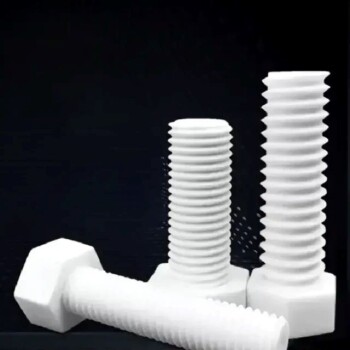
Alumina ceramic screws are fastening components made of 99.5% alumina, ideal for extreme applications requiring excellent thermal resistance, electrical insulation and chemical resistance.

Engineering Advanced Fine Alumina Al2O3 Ceramic Rod Insulated for Industrial Applications
Insulated alumina rod is a fine ceramic material. Alumina rods have excellent electrical insulating properties, high chemical resistance and low thermal expansion.

In the journey of scientific exploration and industrial production, every detail is crucial. Our arc-shaped alumina ceramic crucibles, with their excellent high temperature resistance and stable chemical properties, have become a powerful assistant in laboratories and industrial fields. They are made of high-purity alumina materials and manufactured through precision processes to ensure excellent performance in extreme environments.
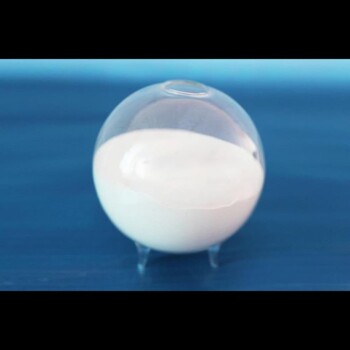
High Purity Alumina Granulated Powder for Engineering Advanced Fine Ceramics
Ordinary alumina granulated powder is alumina particles prepared by traditional processes, with a wide range of applications and good market adaptability. This material is known for its high purity, excellent thermal stability and chemical stability, and is suitable for a variety of high-temperature and conventional applications.

Engineering Advanced Fine Ceramics Alumina Crucibles (Al2O3) for Thermal Analysis TGA DTA
TGA/DTA thermal analysis vessels are made of aluminum oxide (corundum or aluminum oxide). It can withstand high temperature and is suitable for analyzing materials that require high temperature testing.

Alumina ceramics have good electrical conductivity, mechanical strength and high temperature resistance, while zirconia ceramics are known for their high strength and high toughness and are widely used.
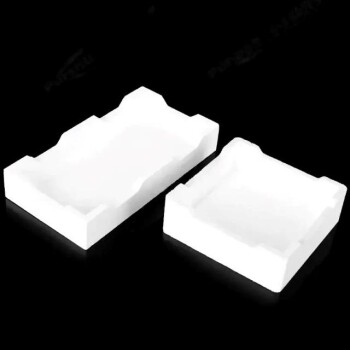
Advanced Engineering Fine Ceramics Alumina Ceramic Saggar for Fine Corundum
Alumina sagger products have the characteristics of high temperature resistance, good thermal shock stability, small expansion coefficient, anti-stripping, and good anti-powdering performance.
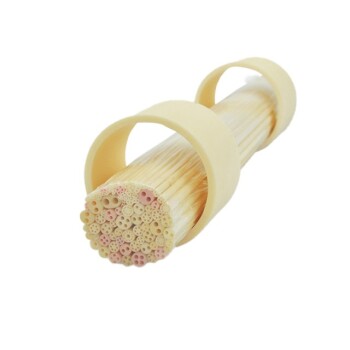
High Temperature Aluminum Oxide (Al2O3) Protective Tube for Engineering Advanced Fine Ceramics
Alumina oxide protective tube, also known as high temperature resistant corundum tube or thermocouple protection tube, is a ceramic tube mainly made of alumina (aluminum oxide).

Precision Machined Zirconia Ceramic Ball for Engineering Advanced Fine Ceramics
zirconia ceramic ball have the characteristics of high strength, high hardness, PPM wear level, high fracture toughness, good wear resistance, and high specific gravity.

Alumina wear-resistant ceramic washer are used for heat dissipation, which can replace aluminum heat sinks, with high temperature resistance and high thermal conductivity.

1700℃ Muffle Oven Furnace for Laboratory
Get superior heat control with our 1700℃ Muffle Furnace. Equipped with intelligent temperature microprocessor, TFT touch screen controller & advanced insulation materials for precise heating up to 1700C. Order now!

Evaporation Crucible for Organic Matter
An evaporation crucible for organic matter, referred to as an evaporation crucible, is a container for evaporating organic solvents in a laboratory environment.

Engineering Advanced Fine Ceramics Aluminum Oxide Al2O3 Heat Sink for Insulation
The hole structure of the ceramic heat sink increases the heat dissipation area in contact with the air, which greatly enhances the heat dissipation effect, and the heat dissipation effect is better than that of super copper and aluminum.

Vacuum Heat Treat and Sintering Furnace with 9MPa Air Pressure
The air pressure sintering furnace is a high-tech equipment commonly used for the sintering of advanced ceramic materials. It combines vacuum sintering and pressure sintering techniques to achieve high-density and high-strength ceramics.

1200℃ Muffle Furnace Oven for Laboratory
Upgrade your lab with our 1200℃ Muffle Furnace. Achieve fast, precise heating with Japan alumina fibers and Molybdenum coils. Features TFT touch screen controller for easy programming and data analysis. Order now!

Silicon Carbide (SIC) Ceramic Plate for Engineering Advanced Fine Ceramics
Silicon nitride (sic) ceramic is an inorganic material ceramic that does not shrink during sintering. It is a high-strength, low-density, high-temperature-resistant covalent bond compound.
Related Articles

The Role of Laboratory Ovens in Scientific Research and Industry
Laboratory ovens are versatile pieces of equipment used in a variety of scientific and industrial settings. They are designed to provide precise temperature control and uniform heating, making them ideal for processes such as baking, curing, and drying various substances.

Comprehensive Guide to Atmosphere Furnaces: Types, Applications, and Benefits
Explore the world of atmosphere furnaces with our detailed guide. Learn about their types, applications in metallurgy and beyond, and the benefits they offer for precise material heat treatment.

Introduction to Various Ceramic Crucibles
An overview of different types of ceramic crucibles, their properties, and applications.

Ceramic Alumina Crucible for Thermal Analysis Test Containers
An in-depth guide on selecting and using ceramic alumina crucibles for thermal analysis tests, focusing on factors affecting test results.

Vacuum Induction Melting Furnace vs Arc Melting Furnace: Choosing the Right Equipment for Your Process
Learn about the key differences between vacuum induction melting furnaces and arc melting furnaces, including their advantages and applications, to help you choose the best equipment for your specific needs.

Alumina Crucibles in Precision Casting
Explores the use of alumina crucibles in precision casting, focusing on their properties and advantages in high-temperature alloy melting.

The Effect of Powder Moisture Content on Cold Isostatic Pressing
Cold Isostatic Pressing (CIP) is a manufacturing process used to create high-density ceramics and metals. This process involves placing the powder into a flexible mold, which is then pressurized with a liquid medium to create a uniform density.

Substances Suitable for Calcination in a High-Temperature Muffle Furnace
An overview of materials and experiments suitable for calcination in a high-temperature muffle furnace.

Advantages of Mullite Fiber Lining for High-Temperature Furnaces
Explores the benefits of mullite fiber linings in high-temperature industrial furnaces, focusing on thermal stability, energy efficiency, and long-term cost savings.

Choosing the Right Muffle Furnace for Laboratory Needs
Guide on selecting muffle furnaces based on temperature, chamber size, and other critical factors.

Comprehensive Guide to Alumina Crucibles in Powder Metallurgy
An in-depth look at the properties, applications, and usage of alumina crucibles in powder metallurgy processes.

Inorganic Non-Metallic Materials: Crucibles
An overview of crucibles made from various inorganic non-metallic materials, their uses, technical parameters, and advantages.